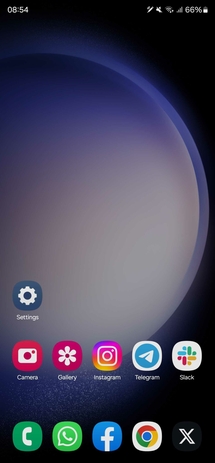
Back ون يو آي Arabic One UI Azerbaijani One UI Catalan One UI Czech One UI German One UI Greek One UI Spanish وان یوآی Persian One UI Finnish One UI French
This article may require cleanup to meet Wikipedia's quality standards. The specific problem is: This article may resemble that of a change-log and should be rewritten to provide a broader historical perspective. (March 2025) |
 | |
 Screenshot of the One UI 7 home screen | |
| Developer | Samsung Electronics |
|---|---|
| OS family | Android (Linux) |
| Working state | Current |
| Initial release | 7 November 2018 |
| Latest release | 7.0 (Based on Android 15) / 22 January 2025 |
| Available in | 100+ languages |
List of languages
| |
| Update method | Firmware over-the-air |
| Kernel type | Monolithic (modified Linux kernel) |
| Userland | Bionic libc,[1] shell from NetBSD,[2] native core utilities[3] |
| Default user interface | Graphical |
| Preceded by | Samsung Experience |
| Official website | Official website |
| Support status | |
| Supported | |
One UI is a user interface (UI) developed by Samsung Electronics for its smart devices, including Android devices from at least late 2016 or early 2017 running Android 9 (Pie) and later. Succeeding Samsung Experience, it is designed to make using larger smartphones easier and be more visually appealing. It was announced & unveiled at Samsung Developer Conference in 2018,[4] and was updated in Galaxy Unpacked in February 2019 alongside the Galaxy S10 series, Galaxy Buds and the Galaxy Fold.
In 2021, Samsung and Google announced the wearable version of Tizen and Wear OS were being merged.[5][6]
The latest version, One UI 7, was released on January 22, 2025.
- ^ "libc – platform/bionic – Git at Google". Android.googlesource.com. Retrieved 2014-03-20.
- ^ "android / platform/system/core / master / . / sh". android.googlesource.com. Archived from the original on 2013-09-22. Retrieved 2014-08-24.
- ^ "toolbox – platform/system/core – Git at Google". Android.googlesource.com. Archived from the original on 2014-02-09. Retrieved 2014-03-20.
- ^ "SDC18 Recap: 5 Factors That Made SDC18 an Event to Remember". Samsung Newsroom. Retrieved 2020-07-17.
- ^ Welch, Chris (2021-05-18). "Google and Samsung are merging Wear OS and Tizen". The Verge. Retrieved 2022-11-10.
- ^ "Google's Wear OS Merges With Samsung's Tizen". PCMAG. 18 May 2021. Retrieved 2022-11-10.
© MMXXIII Rich X Search. We shall prevail. All rights reserved. Rich X Search